In January 1961, human spaceflight was still science fiction—although everyone knew it would soon take place. The flight of Soviet cosmonaut Yuri Gagarin would occur on April 12, with US astronaut Alan Shepard following just weeks later on May 5. But before launching a spacefarer into the “new ocean” of space, NASA wanted one last test of the entire Mercury-Redstone system. This mission would be crewed by the first hominid in space—Ham the “Astrochimp.”
Animals have been the precursors to humans venturing into the heavens since 1783, when the Mongolfier brothers first sent a sheep, a rooster, and a duck aloft in a hot air balloon. In the late 1940s, small animals and insects were flown to ever-greater altitudes during the Cold War’s missile race to determine if humans could eventually travel into space. The USSR favored the use of dogs for these tests, while the United States preferred monkeys, who are biologically more similar to humans.
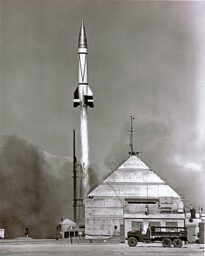
Rhesus macaque Albert II became the first mammal in space in June 1949, reaching an altitude of 83 miles (134 km) aboard a V-2 rocket launched from the White Sands Missile Range. Although Albert and many of his successors met unhappy fates, in May 1959, (Miss) Able (another rhesus macaque) and Miss Baker (a squirrel monkey) made a successful suborbital spaceflight launched on a Jupiter missile and returned safely to earth. Their flight was designed to test both the NASA launch facilities at Cape Canaveral and the procedures for retrieving returning astronauts.
Their safe return catapulted the two monkeys to fame as the United States’ first celebrity space animals; their post-flight press conference was held in the same room where the seven Mercury astronauts had been introduced to the world just a month earlier.
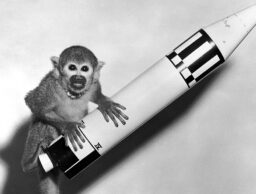
Both female, the two monkeys were named Able and Baker, based on the first two letters of the wartime phonetic alphabet. While Able sadly died a few days after returning, due to an infected telemetry electrode, Baker was re-christened as Miss Baker to correctly recognize her sex, and she lived a comfortable celebrity life for another 25 years. Assumed by the media to be male due to her name, Able’s taxidermied body was displayed in the Smithsonian without the “Miss” designation that Baker acquired. Even today her identity as Miss Able is not fully cemented in history.
Two more rhesus macaques participated in NASA’s Mercury human spaceflight project as test subjects during the Little Joe program, supporting testing of the launch escape system and heat shield for the Mercury capsules. Sam took part in a launch escape system test in December 1959, while the unimaginatively-named Miss Sam endured a high-velocity abort-and-escape test flight in January 1960. The two were later “married” to determine whether spaceflight “impaired the ability to propagate.”
For the final pre-astronaut flight tests, NASA had planned to use chimpanzees due to their greater physiological similarity to humans. A group of 40 candidate “astrochimps” (only one of whom was female!) was assembled at Holloman Aerospace Medical Center, located on Holloman Air Force Base, New Mexico, near Alamogordo. Among them was “No. 65,” who was born in 1957 in what is now the African nation of Cameroon. Captured by animal trappers, he was sent to the United States and eventually sold to the US Air Force in 1959 for $457.
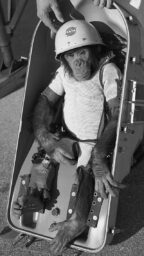
Nicknamed “Chop Chop Chang” by his handlers at Holloman, No. 65 was not formally called “Ham” until after his spaceflight. While the name might seem biblically inspired, it was an acronym for Holloman Aerospace Medical Center, and it also served as a recognition of Lieutenant Colonel Hamilton “Ham” Blackshear, head of the Holloman Aeromedical Field Laboratory where the astrochimps were trained.
At Holloman, Ham the astrochimp learned to perform simple tasks in response to specific lights and sounds. The correct response earned him a banana-flavoured food pellet, while an incorrect response triggered an electric shock to the soles of his feet. As the chimpanzee candidates were winnowed out, Ham made it through to the final six, undergoing 219 hours of training across 15 months.
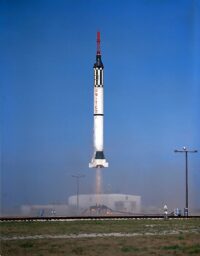
When NASA decided on one final all-up test flight of the Mercury-Redstone system (before astronaut Alan Shepard made what was then anticipated to be the first human spaceflight), star pupil Ham was assigned to the sub-orbital Mercury mission MR-2 (with female chimp “Minnie” as his backup). His 16.5-minute flight on January 31, 1961, made Ham the first great ape—and the first hominid—to go into space.
Fitted with several physiological sensors (including a rectal probe) to monitor his vital signs, Ham’s ability to operate under high acceleration and weightlessness (he experienced over six minutes in zero gravity) was assessed by an apparatus that required him to push one of two levers in response to colored-light cues. Despite technical malfunctions that subjected him to higher than anticipated g-force during launch and re-entry, Ham made only two errors (one of which was due to an equipment failure), demonstrating that complex tasks could be performed in space.
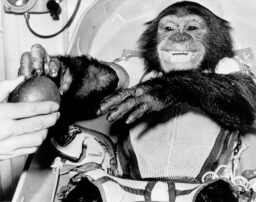
When retrieved after splashing down in the Atlantic Ocean, Ham was dehydrated and had lost a small amount of body weight. He also seemed to be quite agitated by his flight but was otherwise in good condition. The success of his mission paved the way for the first US-crewed spaceflight some months later.
Like Miss Baker before him, Ham became an instant celebrity, and when he retired from NASA in 1963, he lived comfortably in zoo-housed chimpanzee groups until his death in 1983. His grave is located at the New Mexico Museum of Space History in Alamogordo, New Mexico, though his skeleton is in the collection of the National Museum of Health and Medicine, Silver Spring, Maryland.
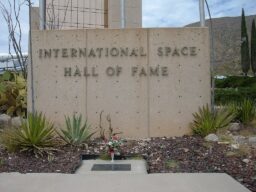
While considered crucial to space research at the time, modern animal research ethics would not approve the invasive—and sometimes harmful—nature of the Holloman training techniques, and even in the early 1960s, animal rights groups protested the use of chimpanzees in space research. However, because of their crucial work and sacrifice, these animals deserve to be lauded as the heroes they are, perhaps more than the humans who followed after.

